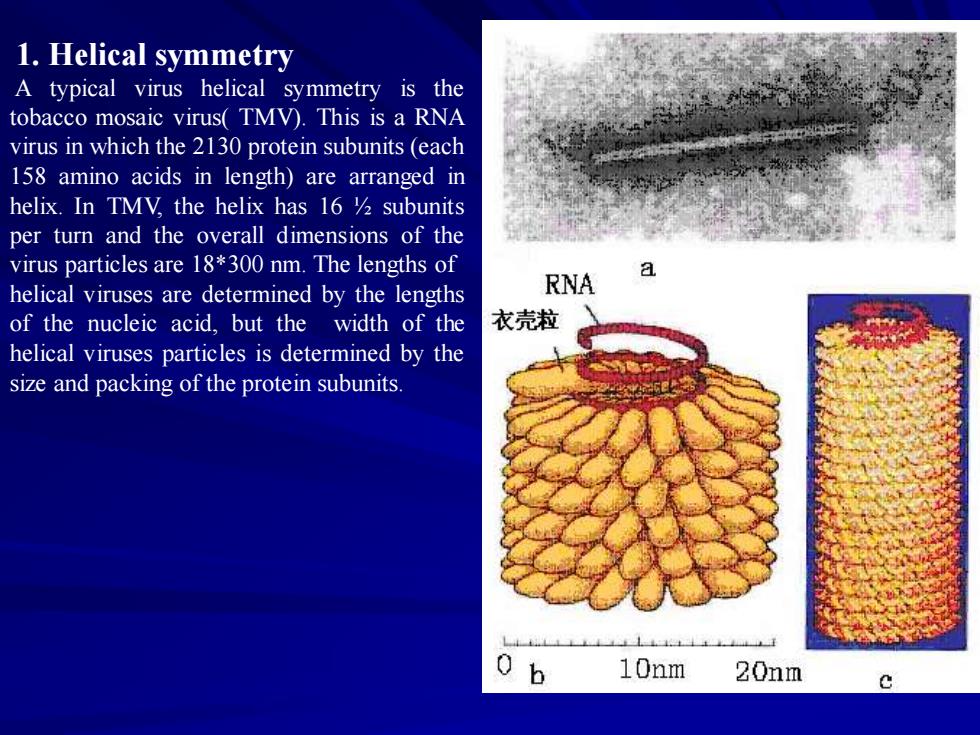
1.Helical symmetry a typical virus helical symmetry is the tobacco mosaic virus(TMV).This is a RNA virus in which the 2130 protein subunits (each 158 amino acids in length)are arranged in helix.In TMV,the helix has 16 subunits per turn and the overall dimensions of the virus particles are 18*300 nm.The lengths of a helical viruses are determined by the lengths RNA of the nucleic acid,but the width of the 衣壳拉 helical viruses particles is determined by the size and packing of the protein subunits. 10nm 20nm
1. Helical symmetry A typical virus helical symmetry is the tobacco mosaic virus( TMV). This is a RNA virus in which the 2130 protein subunits (each 158 amino acids in length) are arranged in helix. In TMV, the helix has 16 ½ subunits per turn and the overall dimensions of the virus particles are 18*300 nm. The lengths of helical viruses are determined by the lengths of the nucleic acid, but the width of the helical viruses particles is determined by the size and packing of the protein subunits
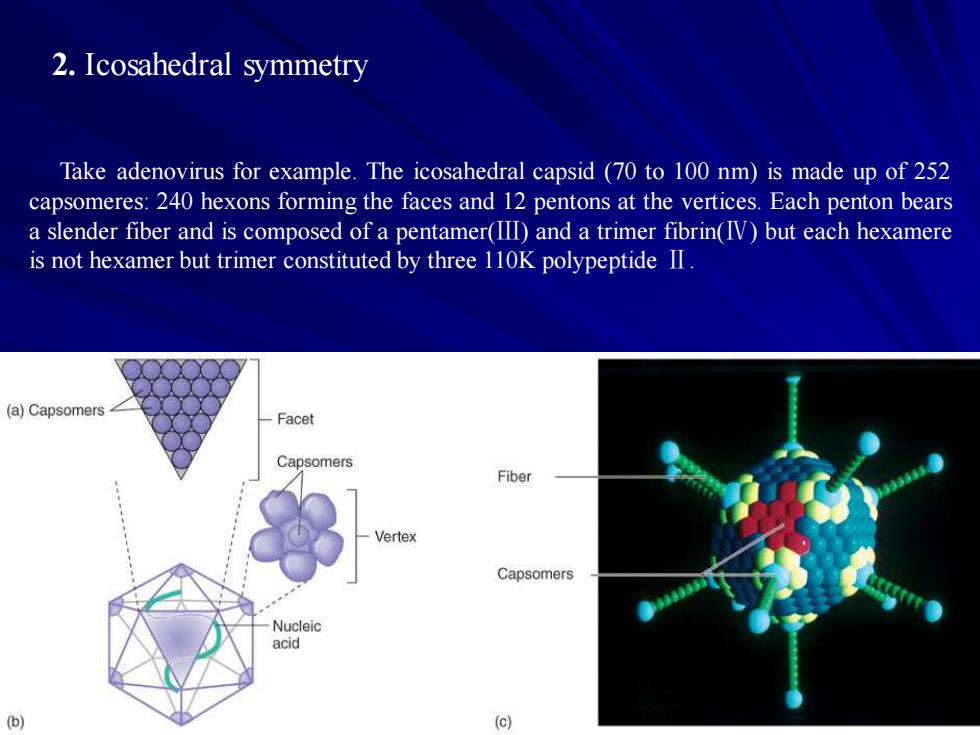
2.Icosahedral symmetry Take adenovirus for example.The icosahedral capsid (70 to 100 nm)is made up of 252 capsomeres:240 hexons forming the faces and 12 pentons at the vertices.Each penton bears a slender fiber and is composed of a pentamer(III)and a trimer fibrin(IV)but each hexamere is not hexamer but trimer constituted by three 110K polypeptide II (a)Capsomers Facet Capsomers Fiber Vertex Capsomers Nucleic acid (b)
2. Icosahedral symmetry Take adenovirus for example. The icosahedral capsid (70 to 100 nm) is made up of 252 capsomeres: 240 hexons forming the faces and 12 pentons at the vertices. Each penton bears a slender fiber and is composed of a pentamer(Ⅲ) and a trimer fibrin(Ⅳ) but each hexamere is not hexamer but trimer constituted by three 110K polypeptide Ⅱ
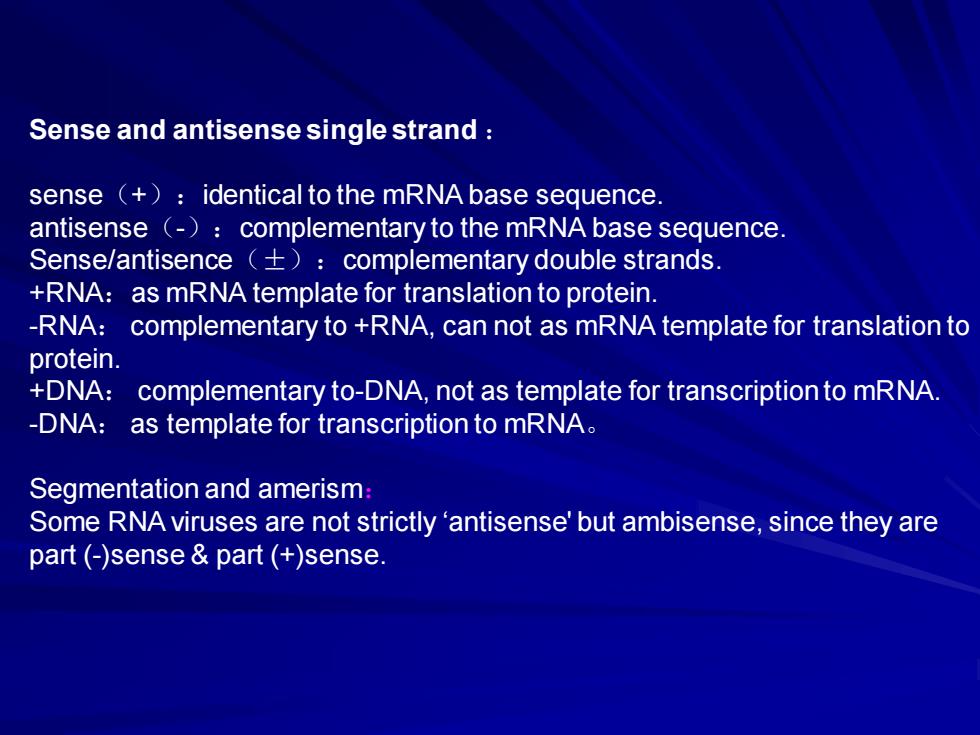
Sense and antisense single strand sense (+)identical to the mRNA base sequence. antisense (-)complementary to the mRNA base sequence. Sense/antisence (+)complementary double strands +RNA:as mRNA template for translation to protein. -RNA:complementary to +RNA,can not as mRNA template for translation to protein. +DNA:complementary to-DNA,not as template for transcription to mRNA. -DNA:as template for transcription to mRNA. Segmentation and amerism: Some RNA viruses are not strictly 'antisense'but ambisense,since they are part (-)sense part (+)sense
Sense and antisense single strand : sense(+):identical to the mRNA base sequence. antisense(-):complementary to the mRNA base sequence. Sense/antisence(±):complementary double strands. +RNA:as mRNA template for translation to protein. -RNA: complementary to +RNA, can not as mRNA template for translation to protein. +DNA: complementary to-DNA, not as template for transcription to mRNA. -DNA: as template for transcription to mRNA。 Segmentation and amerism: Some RNA viruses are not strictly ‘antisense' but ambisense, since they are part (-)sense & part (+)sense
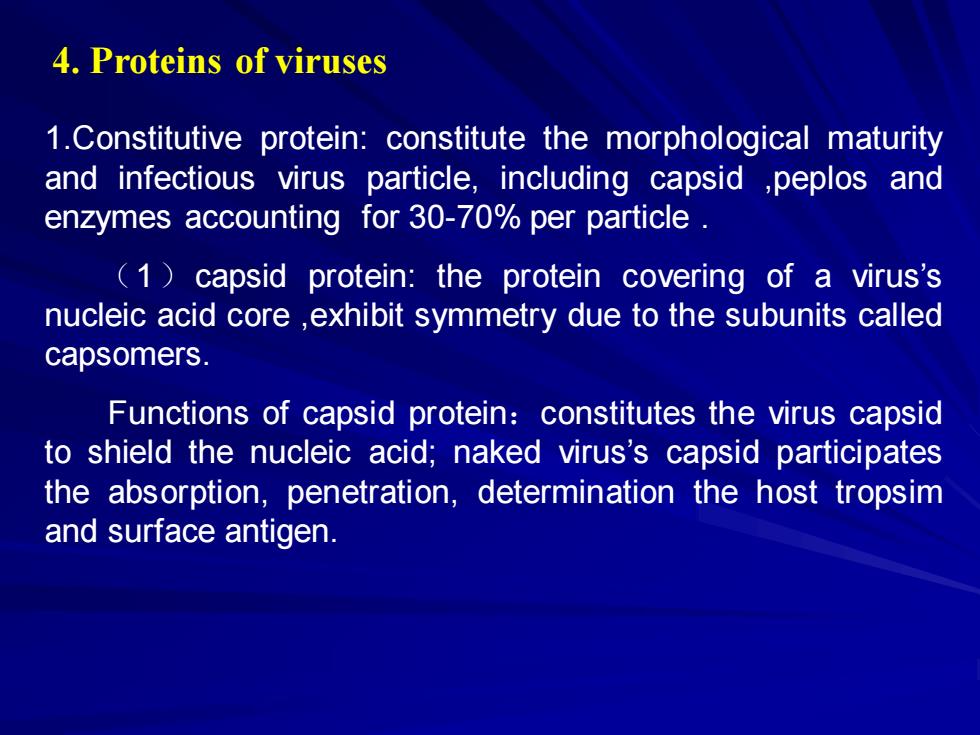
4.Proteins of viruses 1.Constitutive protein:constitute the morphological maturity and infectious virus particle,including capsid ,peplos and enzymes accounting for 30-70%per particle (1)capsid protein:the protein covering of a virus's nucleic acid core exhibit symmetry due to the subunits called capsomers. Functions of capsid protein:constitutes the virus capsid to shield the nucleic acid;naked virus's capsid participates the absorption,penetration,determination the host tropsim and surface antigen
4. Proteins of viruses 1.Constitutive protein: constitute the morphological maturity and infectious virus particle, including capsid ,peplos and enzymes accounting for 30-70% per particle . (1)capsid protein: the protein covering of a virus’s nucleic acid core ,exhibit symmetry due to the subunits called capsomers. Functions of capsid protein:constitutes the virus capsid to shield the nucleic acid; naked virus’s capsid participates the absorption, penetration, determination the host tropsim and surface antigen
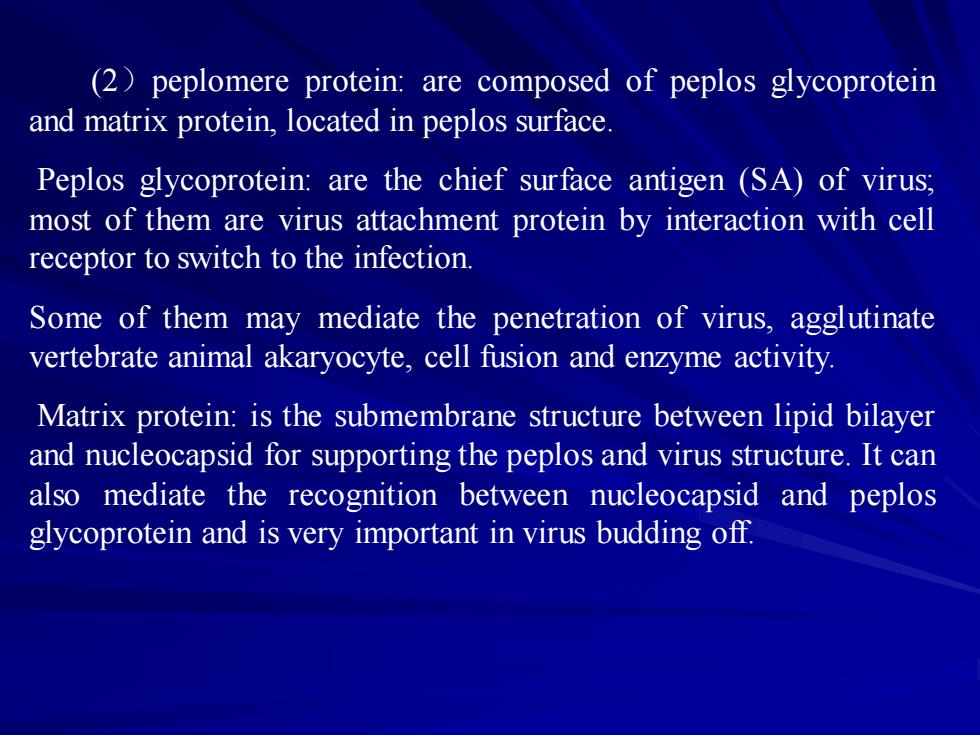
(2)peplomere protein:are composed of peplos glycoprotein and matrix protein,located in peplos surface. Peplos glycoprotein:are the chief surface antigen (SA)of virus; most of them are virus attachment protein by interaction with cell receptor to switch to the infection. Some of them may mediate the penetration of virus,agglutinate vertebrate animal akaryocyte,cell fusion and enzyme activity Matrix protein:is the submembrane structure between lipid bilayer and nucleocapsid for supporting the peplos and virus structure.It can also mediate the recognition between nucleocapsid and peplos glycoprotein and is very important in virus budding off
(2)peplomere protein: are composed of peplos glycoprotein and matrix protein, located in peplos surface. Peplos glycoprotein: are the chief surface antigen (SA) of virus; most of them are virus attachment protein by interaction with cell receptor to switch to the infection. Some of them may mediate the penetration of virus, agglutinate vertebrate animal akaryocyte, cell fusion and enzyme activity. Matrix protein: is the submembrane structure between lipid bilayer and nucleocapsid for supporting the peplos and virus structure. It can also mediate the recognition between nucleocapsid and peplos glycoprotein and is very important in virus budding off